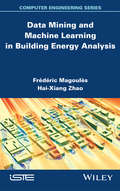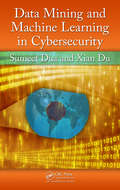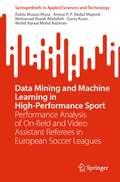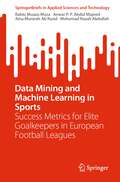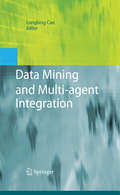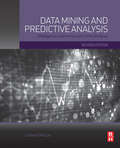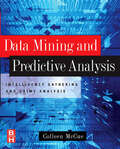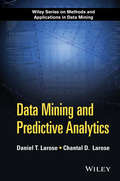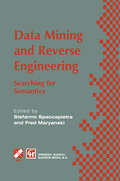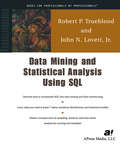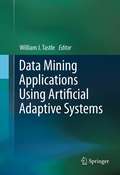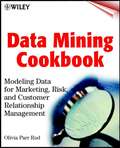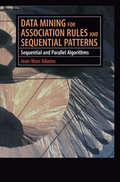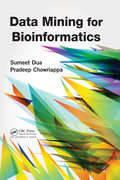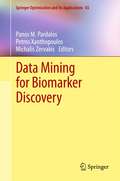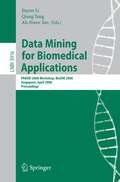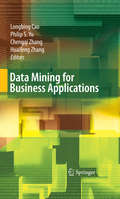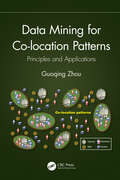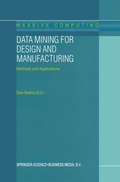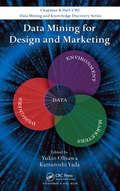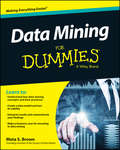- Table View
- List View
Data Mining and Machine Learning in Building Energy Analysis: Towards High Performance Computing
by Frédéric Magoules Hai-Xiang ZhaoFocusing on up-to-date artificial intelligence models to solve building energy problems, Artificial Intelligence for Building Energy Analysis reviews recently developed models for solving these issues, including detailed and simplified engineering methods, statistical methods, and artificial intelligence methods. The text also simulates energy consumption profiles for single and multiple buildings. Based on these datasets, Support Vector Machine (SVM) models are trained and tested to do the prediction. Suitable for novice, intermediate, and advanced readers, this is a vital resource for building designers, engineers, and students.
Data Mining and Machine Learning in Cybersecurity
by Sumeet Dua Xian DuWith the rapid advancement of information discovery techniques, machine learning and data mining continue to play a significant role in cybersecurity. Although several conferences, workshops, and journals focus on the fragmented research topics in this area, there has been no single interdisciplinary resource on past and current works and possible
Data Mining and Machine Learning in Cybersecurity
by Sumeet Dua Xian DuWith the rapid advancement of information discovery techniques, machine learning and data mining continue to play a significant role in cybersecurity. Although several conferences, workshops, and journals focus on the fragmented research topics in this area, there has been no single interdisciplinary resource on past and current works and possible
Data Mining and Machine Learning in High-Performance Sport: Performance Analysis of On-field and Video Assistant Referees in European Soccer Leagues (SpringerBriefs in Applied Sciences and Technology)
by Rabiu Muazu Musa Anwar P.P. Abdul Majeed Mohd Azraai Mohd Razman Mohamad Razali Abdullah Garry KuanThis book explores the application of data mining and machine learning techniques in studying the activity pattern, decision-making skills, misconducts, and actions resulting in the intervention of VAR in European soccer leagues referees. The game of soccer at the elite level is characterised by intense competitions, a high level of intensity, technical, and tactical skills coupled with a long duration of play. Referees are required to officiate the game and deliver correct and indisputable decisions throughout the duration of play. The increase in the spatial and temporal task demands of the game necessitates that the referees must respond and cope with the physiological and psychological loads inherent in the game. The referees are also required to deliver an accurate decision and uphold the rules and regulations of the game during a match. These demands and attributes make the work of referees highly complex. The increasing pace and complexity of the game resulted in the introduction of the Video Assistant Referee (VAR) to assist and improve the decision-making of on-field referees. Despite the integration of VAR into the current refereeing system, the performances of the referees are yet to be error-free. Machine learning coupled with data mining techniques has shown to be vital in providing insights from a large dataset which could be used to draw important inferences that can aid decision-making for diagnostics purposes and overall performance improvement. A total of 6232 matches from 5 consecutive seasons officiated across the English Premier League, Spanish LaLiga, Italian Serie A as well as the German Bundesliga was studied. It is envisioned that the findings in this book could be useful in recognising the activity pattern of top-class referees, that is non-trivial for the stakeholders in devising strategies to further enhance the performances of referees as well as empower talent identification experts with pertinent information for mapping out future high-performance referees.
Data Mining and Machine Learning in Sports: Success Metrics for Elite Goalkeepers in European Football Leagues (SpringerBriefs in Applied Sciences and Technology)
by Rabiu Muazu Musa Anwar P. Majeed Aina Munirah Ab Rasid Mohamad Razali AbdullahThis brief highlights the factors associated with good goalkeeping techniques and their impact on goalkeepers’ performance in elite European football leagues. The goalkeeping performances of 1600 goalkeepers from five consecutive seasons across the English Premier League, Spanish La Liga, Italian Serie A, and German Bundesliga are studied. The findings from this brief are useful for identifying the success metrices of top-class goalkeepers that help stakeholders to devise strategies to further enhance their performances and empower talent identification experts with pertinent information for mapping out future high-performance goalkeepers.
Data Mining and Multi-agent Integration
by Longbing CaoData Mining and Multi agent Integration aims to re?ect state of the art research and development of agent mining interaction and integration (for short, agent min ing). The book was motivated by increasing interest and work in the agents data min ing, and vice versa. The interaction and integration comes about from the intrinsic challenges faced by agent technology and data mining respectively; for instance, multi agent systems face the problem of enhancing agent learning capability, and avoiding the uncertainty of self organization and intelligence emergence. Data min ing, if integrated into agent systems, can greatly enhance the learning skills of agents, and assist agents with predication of future states, thus initiating follow up action or intervention. The data mining community is now struggling with mining distributed, interactive and heterogeneous data sources. Agents can be used to man age such data sources for data access, monitoring, integration, and pattern merging from the infrastructure, gateway, message passing and pattern delivery perspectives. These two examples illustrate the potential of agent mining in handling challenges in respective communities. There is an excellent opportunity to create innovative, dual agent mining interac tion and integration technology, tools and systems which will deliver results in one new technology.
Data Mining and Predictive Analysis: Intelligence Gathering and Crime Analysis
by Colleen McCueData Mining and Predictive Analysis: Intelligence Gathering and Crime Analysis, 2nd Edition, describes clearly and simply how crime clusters and other intelligence can be used to deploy security resources most effectively. Rather than being reactive, security agencies can anticipate and prevent crime through the appropriate application of data mining and the use of standard computer programs. Data Mining and Predictive Analysis offers a clear, practical starting point for professionals who need to use data mining in homeland security, security analysis, and operational law enforcement settings. This revised text highlights new and emerging technology, discusses the importance of analytic context for ensuring successful implementation of advanced analytics in the operational setting, and covers new analytic service delivery models that increase ease of use and access to high-end technology and analytic capabilities. The use of predictive analytics in intelligence and security analysis enables the development of meaningful, information based tactics, strategy, and policy decisions in the operational public safety and security environment.Discusses new and emerging technologies and techniques, including up-to-date information on predictive policing, a key capability in law enforcement and securityDemonstrates the importance of analytic context beyond softwareCovers new models for effective delivery of advanced analytics to the operational environment, which have increased access to even the most powerful capabilitiesIncludes terminology, concepts, practical application of these concepts, and examples to highlight specific techniques and approaches in crime and intelligence analysis
Data Mining and Predictive Analysis: Intelligence Gathering and Crime Analysis
by Colleen McCueIt is now possible to predict the future when it comes to crime. In Data Mining and Predictive Analysis, Dr. Colleen McCue describes not only the possibilities for data mining to assist law enforcement professionals, but also provides real-world examples showing how data mining has identified crime trends, anticipated community hot-spots, and refined resource deployment decisions. In this book Dr. McCue describes her use of "off the shelf" software to graphically depict crime trends and to predict where future crimes are likely to occur. Armed with this data, law enforcement executives can develop "risk-based deployment strategies," that allow them to make informed and cost-efficient staffing decisions based on the likelihood of specific criminal activity.Knowledge of advanced statistics is not a prerequisite for using Data Mining and Predictive Analysis. The book is a starting point for those thinking about using data mining in a law enforcement setting. It provides terminology, concepts, practical application of these concepts, and examples to highlight specific techniques and approaches in crime and intelligence analysis, which law enforcement and intelligence professionals can tailor to their own unique situation and responsibilities.* Serves as a valuable reference tool for both the student and the law enforcement professional* Contains practical information used in real-life law enforcement situations* Approach is very user-friendly, conveying sophisticated analyses in practical terms
Data Mining and Predictive Analytics (Wiley Series on Methods and Applications in Data Mining)
by Daniel T. LaroseLearn methods of data analysis and their application to real-world data sets This updated second edition serves as an introduction to data mining methods and models, including association rules, clustering, neural networks, logistic regression, and multivariate analysis. The authors apply a unified “white box” approach to data mining methods and models. This approach is designed to walk readers through the operations and nuances of the various methods, using small data sets, so readers can gain an insight into the inner workings of the method under review. Chapters provide readers with hands-on analysis problems, representing an opportunity for readers to apply their newly-acquired data mining expertise to solving real problems using large, real-world data sets. Data Mining and Predictive Analytics: Offers comprehensive coverage of association rules, clustering, neural networks, logistic regression, multivariate analysis, and R statistical programming language Features over 750 chapter exercises, allowing readers to assess their understanding of the new material Provides a detailed case study that brings together the lessons learned in the book Includes access to the companion website, www.dataminingconsultant, with exclusive password-protected instructor content Data Mining and Predictive Analytics will appeal to computer science and statistic students, as well as students in MBA programs, and chief executives.
Data Mining and Predictive Analytics (Wiley Series on Methods and Applications in Data Mining)
by Daniel T. LaroseLearn methods of data analysis and their application to real-world data sets This updated second edition serves as an introduction to data mining methods and models, including association rules, clustering, neural networks, logistic regression, and multivariate analysis. The authors apply a unified “white box” approach to data mining methods and models. This approach is designed to walk readers through the operations and nuances of the various methods, using small data sets, so readers can gain an insight into the inner workings of the method under review. Chapters provide readers with hands-on analysis problems, representing an opportunity for readers to apply their newly-acquired data mining expertise to solving real problems using large, real-world data sets. Data Mining and Predictive Analytics: Offers comprehensive coverage of association rules, clustering, neural networks, logistic regression, multivariate analysis, and R statistical programming language Features over 750 chapter exercises, allowing readers to assess their understanding of the new material Provides a detailed case study that brings together the lessons learned in the book Includes access to the companion website, www.dataminingconsultant, with exclusive password-protected instructor content Data Mining and Predictive Analytics will appeal to computer science and statistic students, as well as students in MBA programs, and chief executives.
Data Mining and Reverse Engineering: Searching for semantics. IFIP TC2 WG2.6 IFIP Seventh Conference on Database Semantics (DS-7) 7–10 October 1997, Leysin, Switzerland (IFIP Advances in Information and Communication Technology)
by Stefano Spaccapietra Fred MaryanskiSearching for Semantics: Data Mining, Reverse Engineering Stefano Spaccapietra Fred M aryanski Swiss Federal Institute of Technology University of Connecticut Lausanne, Switzerland Storrs, CT, USA REVIEW AND FUTURE DIRECTIONS In the last few years, database semantics research has turned sharply from a highly theoretical domain to one with more focus on practical aspects. The DS- 7 Working Conference held in October 1997 in Leysin, Switzerland, demon strated the more pragmatic orientation of the current generation of leading researchers. The papers presented at the meeting emphasized the two major areas: the discovery of semantics and semantic data modeling. The work in the latter category indicates that although object-oriented database management systems have emerged as commercially viable prod ucts, many fundamental modeling issues require further investigation. Today's object-oriented systems provide the capability to describe complex objects and include techniques for mapping from a relational database to objects. However, we must further explore the expression of information regarding the dimensions of time and space. Semantic models possess the richness to describe systems containing spatial and temporal data. The challenge of in corporating these features in a manner that promotes efficient manipulation by the subject specialist still requires extensive development.
Data Mining and Statistical Analysis Using SQL
by John Lovett Robert P. TruebloodThis book is not just another theoretical text on statistics or data mining. Instead, it's designed for database administrators who want to buttress their understanding of statistics to support data mining and customer relationship management analytics and who want to use Structured Query Language (SQL). Each chapter is independent and self-contained with examples tailored to business applications. Each analysis technique is expressed in a mathematical format that lends itself to coding either as a database query or as a Visual Basic procedure using SQL. Each chapter includes: formulas (how to perform the required analysis, numerical example using data from a database, data visualization and presentation options (graphs, charts, tables), SQL procedures for extracting the desired results, and data mining techniques.
Data Mining Applications Using Artificial Adaptive Systems
by William J. TastleThis volume directly addresses the complexities involved in data mining and the development of new algorithms, built on an underlying theory consisting of linear and non-linear dynamics, data selection, filtering, and analysis, while including analytical projection and prediction. The results derived from the analysis are then further manipulated such that a visual representation is derived with an accompanying analysis. The book brings very current methods of analysis to the forefront of the discipline, provides researchers and practitioners the mathematical underpinning of the algorithms, and the non-specialist with a visual representation such that a valid understanding of the meaning of the adaptive system can be attained with careful attention to the visual representation. The book presents, as a collection of documents, sophisticated and meaningful methods that can be immediately understood and applied to various other disciplines of research. The content is composed of chapters addressing: An application of adaptive systems methodology in the field of post-radiation treatment involving brain volume differences in children; A new adaptive system for computer-aided diagnosis of the characterization of lung nodules; A new method of multi-dimensional scaling with minimal loss of information; A description of the semantics of point spaces with an application on the analysis of terrorist attacks in Afghanistan; The description of a new family of meta-classifiers; A new method of optimal informational sorting; A general method for the unsupervised adaptive classification for learning; and the presentation of two new theories, one in target diffusion and the other in twisting theory.
Data Mining Cookbook: Modeling Data for Marketing, Risk, and Customer Relationship Management
by Olivia Parr RudIncrease profits and reduce costs by utilizing this collection of models of the most commonly asked data mining questions In order to find new ways to improve customer sales and support, and as well as manage risk, business managers must be able to mine company databases. This book provides a step-by-step guide to creating and implementing models of the most commonly asked data mining questions. Readers will learn how to prepare data to mine, and develop accurate data mining questions. The author, who has over ten years of data mining experience, also provides actual tested models of specific data mining questions for marketing, sales, customer service and retention, and risk management. A CD-ROM, sold separately, provides these models for reader use.
Data Mining for Association Rules and Sequential Patterns: Sequential and Parallel Algorithms
by Jean-Marc AdamoRecent advances in data collection, storage technologies, and computing power have made it possible for companies, government agencies and scientific laboratories to keep and manipulate vast amounts of data relating to their activities. This state-of-the-art monograph discusses essential algorithms for sophisticated data mining methods used with large-scale databases, focusing on two key topics: association rules and sequential pattern discovery. This will be an essential book for practitioners and professionals in computer science and computer engineering.
Data Mining for Bioinformatics
by Sumeet Dua Pradeep ChowriappaCovering theory, algorithms, and methodologies, as well as data mining technologies, Data Mining for Bioinformatics provides a comprehensive discussion of data-intensive computations used in data mining with applications in bioinformatics. It supplies a broad, yet in-depth, overview of the application domains of data mining for bioinformatics to he
Data Mining for Bioinformatics
by Sumeet Dua Pradeep ChowriappaCovering theory, algorithms, and methodologies, as well as data mining technologies, Data Mining for Bioinformatics provides a comprehensive discussion of data-intensive computations used in data mining with applications in bioinformatics. It supplies a broad, yet in-depth, overview of the application domains of data mining for bioinformatics to he
Data Mining for Biomarker Discovery (Springer Optimization and Its Applications #65)
by Panos M. Pardalos Petros Xanthopoulos Michalis ZervakisBiomarker discovery is an important area of biomedical research that may lead to significant breakthroughs in disease analysis and targeted therapy. Biomarkers are biological entities whose alterations are measurable and are characteristic of a particular biological condition. Discovering, managing, and interpreting knowledge of new biomarkers are challenging and attractive problems in the emerging field of biomedical informatics.This volume is a collection of state-of-the-art research into the application of data mining to the discovery and analysis of new biomarkers. Presenting new results, models and algorithms, the included contributions focus on biomarker data integration, information retrieval methods, and statistical machine learning techniques.This volume is intended for students, and researchers in bioinformatics, proteomics, and genomics, as well engineers and applied scientists interested in the interdisciplinary application of data mining techniques.
Data Mining for Biomedical Applications: PAKDD 2006 Workshop, BioDM 2006, Singapore, April 9, 2006, Proceedings (Lecture Notes in Computer Science #3916)
by Jinyan Li Qiang Yang Ah-Hwee TanThis book constitutes the refereed proceedings of the International Workshop on Data Mining for Biomedical Applications, BioDM 2006, held in Singapore in conjunction with the 10th Pacific-Asia Conference on Knowledge Discovery and Data Mining (PAKDD 2006). The 14 revised full papers presented together with one keynote talk were carefully reviewed and selected from 35 submissions. The papers are organized in topical sections
Data Mining for Business Applications
by Longbing Cao Philip S. Yu Chengqi Zhang Huaifeng ZhangData Mining for Business Applications presents the state-of-the-art research and development outcomes on methodologies, techniques, approaches and successful applications in the area. The contributions mark a paradigm shift from “data-centered pattern mining” to “domain driven actionable knowledge discovery” for next-generation KDD research and applications. The contents identify how KDD techniques can better contribute to critical domain problems in theory and practice, and strengthen business intelligence in complex enterprise applications. The volume also explores challenges and directions for future research and development in the dialogue between academia and business.
Data Mining for Co-location Patterns: Principles and Applications
by Guoqing ZhouCo-location pattern mining detects sets of features frequently located in close proximity to each other. This book focuses on data mining for co-location pattern, a valid method for identifying patterns from all types of data and applying them in business intelligence and analytics. It explains the fundamentals of co-location pattern mining, co-location decision tree, and maximal instance co-location pattern mining along with an in-depth overview of data mining, machine learning, and statistics. This arrangement of chapters helps readers understand the methods of co-location pattern mining step-by-step and their applications in pavement management, image classification, geospatial buffer analysis, etc.
Data Mining for Co-location Patterns: Principles and Applications
by Guoqing ZhouCo-location pattern mining detects sets of features frequently located in close proximity to each other. This book focuses on data mining for co-location pattern, a valid method for identifying patterns from all types of data and applying them in business intelligence and analytics. It explains the fundamentals of co-location pattern mining, co-location decision tree, and maximal instance co-location pattern mining along with an in-depth overview of data mining, machine learning, and statistics. This arrangement of chapters helps readers understand the methods of co-location pattern mining step-by-step and their applications in pavement management, image classification, geospatial buffer analysis, etc.
Data Mining for Design and Manufacturing: Methods and Applications (Massive Computing #3)
by D. BrahaData Mining for Design and Manufacturing: Methods and Applications is the first book that brings together research and applications for data mining within design and manufacturing. The aim of the book is 1) to clarify the integration of data mining in engineering design and manufacturing, 2) to present a wide range of domains to which data mining can be applied, 3) to demonstrate the essential need for symbiotic collaboration of expertise in design and manufacturing, data mining, and information technology, and 4) to illustrate how to overcome central problems in design and manufacturing environments. The book also presents formal tools required to extract valuable information from design and manufacturing data, and facilitates interdisciplinary problem solving for enhanced decision making. Audience: The book is aimed at both academic and practising audiences. It can serve as a reference or textbook for senior or graduate level students in Engineering, Computer, and Management Sciences who are interested in data mining technologies. The book will be useful for practitioners interested in utilizing data mining techniques in design and manufacturing as well as for computer software developers engaged in developing data mining tools.
Data Mining for Design and Marketing
by Yukio Ohsawa Katsutoshi YadaData Mining for Design and Marketing shows how to design and integrate data mining tools into human thinking processes in order to make better business decisions, especially in designing and marketing products and systems.The expert contributors discuss how data mining can identify valuable consumer patterns, which aid marketers and designers in de
Data Mining For Dummies
by Meta S. BrownDelve into your data for the key to success Data mining is quickly becoming integral to creating value and business momentum. The ability to detect unseen patterns hidden in the numbers exhaustively generated by day-to-day operations allows savvy decision-makers to exploit every tool at their disposal in the pursuit of better business. By creating models and testing whether patterns hold up, it is possible to discover new intelligence that could change your business's entire paradigm for a more successful outcome. Data Mining for Dummies shows you why it doesn't take a data scientist to gain this advantage, and empowers average business people to start shaping a process relevant to their business's needs. In this book, you'll learn the hows and whys of mining to the depths of your data, and how to make the case for heavier investment into data mining capabilities. The book explains the details of the knowledge discovery process including: Model creation, validity testing, and interpretation Effective communication of findings Available tools, both paid and open-source Data selection, transformation, and evaluation Data Mining for Dummies takes you step-by-step through a real-world data-mining project using open-source tools that allow you to get immediate hands-on experience working with large amounts of data. You'll gain the confidence you need to start making data mining practices a routine part of your successful business. If you're serious about doing everything you can to push your company to the top, Data Mining for Dummies is your ticket to effective data mining.
